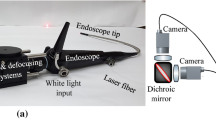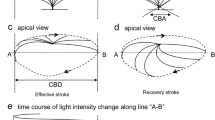Summary
The purpose of this study was to investigate whether the ciliary beat frequency (CBF) is influenced by the nasal cycle. Nasal patency was assessed by active anterior rhinomanometry and immediately followed by measuring CBF in biopsies taken from the posterior aspect of the inferior turbinates in 22 healthy volunteers. CBF was determined in three different cells of each biopsy by means of a phase-contrast microscope and a photoelectrical cell. The signal was analyzed by a computed power spectrum. The frequency and its shift were calculated for a period of 20 s. The results were as follows: (1) no correlation was found between CBF and nasal patency; (2) CBF in one cell is constant to a high degree; (3) CBF of different cells in the same biopsy specimen varies considerably.
Similar content being viewed by others
References
Deitmer T (1986) A method for standardizing cytologic sampling for the estimation of nasal ciliary activity. Arch Otorhinolaryngol 243: 288–292
Doyle WJ, Cauwenberge PB van (1987) Relationship between nasal patency and clearance. Rhinology 25: 167–179
Duchateau GSMJE, Graamans K, Zuidema J (1985) Correlation between nasal ciliary beat frequency and mucus transport rate in volunteers. Laryngoscope 95: 854–859
Dulfano MJ, Luk CK, Beckage M, Wooten O (1981) Ciliary beat frequency in human respiratory explants. Am Rev Respir Disl 23: 139–140
Eccles R (1978) The central rhythm of the nasal cycle. Acta Otolaryngol (Stockh) 86: 464–468
Hybbinette JC, Mercke U (1980) Effects of sympathomimetic agonists and antagonists of mucociliary activity. Acta Otolaryngol (Stockh) 94: 121–130
Hybbinette JC, Mercke U (1982) Effects of the parasympathetic drug methacholine and its antagonist atropine on mucociliary activity. Acta Otolaryngol (Stockh) 93: 465–473
Kennedy JR, Duckett KE (1981) The study of ciliary frequencies with an optical spectrum analysis system. Exp Cell Res 135: 147–156
Keuning J (1968) On the nasal cycle. Int Rhinol 6: 99–136
Konietzko N, Nakhosteen JA, Mizera W, Kasparek, Hesse H (1981) Ciliary beat frequency of biopsy samples taken from normal persons and patients with various lung diseases. Chest [Suppl] 80: 855–857
Lopez-Vidriero MT (1982) Objective criteria for measuring ciliary beat frequency in vitro. Am Rev Respir Dir 125 [Suppl 4]: 244
Mercke U, Hybbinette JC, Lindberg S (1982) Parasympathetic and sympathetic influences on mucociliary activity in vivo. Rhinology 20: 201–204
Mygind N, Pedersen M, Nielsen M (1982) Morphology of the upper airway epithelium. In: Proctor DF, Anderson IB (eds) The nose: upper airway physiology and the atmospheric environment, 1st edn. Elsevier, Amsterdam, p 71
Ohashi Y, Nakai Y, Kihara S, Ikeoka H, Takano H, Imoto T (1985) Ciliary activity in patients with nasal allergies. Arch Otorhinolaryngol 242: 141–147
Ohashi Y, Nakai Y, Muraoka M (1986) Abnormal mucociliary function in a mucocoele of the maxillary antrum. Arch Otorhinolaryngol 243: 207–210
Parker RC (1957) Special publications. NY Acad Sci 5: 303
Pedersen M (1983) Specific types of abnormal ciliary motility in Kartagener's syndrome and analogous respiratory disorders (a quantified micro-oscillografic investigation of 27 patients). Eur J Respir Dis 64 [Suppl 127]: 78–90
Pedersen M, Sakakura Y, Winther B, Brofeldt S, Myging N (1983) Nasal mucociliary transport, number of ciliated cells and beating pattern in naturally acquired common cold. Eur 9 Respir Dis 64 [Suppl 128]: 355–364
Rutland J, Cole PJ (1980) Non-invasive sampling of nasal cilia for measurement of beat frequency and study of ultrastructure. Lancet II: 564
Yager J, Tzeng-Ming Chen, Dulfano MJ (1978) Measurement of frequency of ciliary beats of human respiratory epithelium. Chest 73: 627–633
Author information
Authors and Affiliations
Additional information
Offprint requests to: K. Ingels
Rights and permissions
About this article
Cite this article
Ingels, K.J.A.0., Meeuwsen, F., van Strien, H.L.C.J. et al. Ciliary beat frequency and the nasal cycle. Eur Arch Otorhinolaryngol 248, 123–126 (1990). https://doi.org/10.1007/BF00240235
Received:
Accepted:
Issue Date:
DOI: https://doi.org/10.1007/BF00240235




